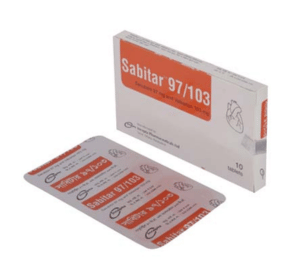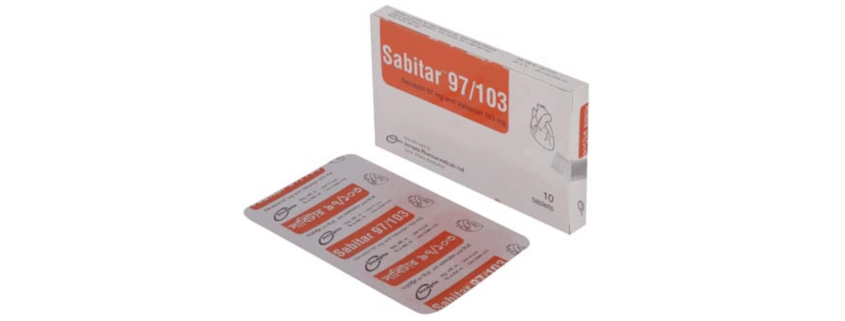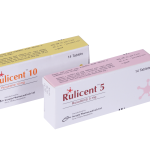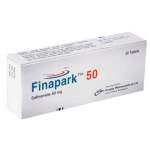Sabitar (Sacubitril and Valsartan)

Therapeutic Group: Combined Antihypertensive preparation
Presentation
Sabitar 50: Each film coated tablet contains Sacubitril Valsartan Sodium Hemipentahydrate
INN equivalent to Sacubitril 24 mg and Valsartan 26 mg.
Sabitar 100: Each film coated tablet contains Sacubitril Valsartan Sodium Hemipentahydrate
INN equivalent to Sacubitril 49 mg and Valsartan 51 mg.
Sabitar 200: Each film coated tablet contains Sacubitril Valsartan Sodium Hemipentahydrate
INN equivalent to Sacubitril 97 mg and Valsartan 103 mg.
Description
Sacubitril, a neprilysin inhibitor that inhibits neprilysin (neutral endopeptidase; NEP) via active metabolite of the prodrug sacubitril. Valsartan, a angiotensin receptor blocker that blocks the angiotensin II type-1 (AT1) receptor. The cardiovascular and renal effects of Sacubitril/Valsartan in heart failure patients are attributed to the increased levels of peptides that are degraded by neprilysin, such as natriuretic peptides by the active metabolite of sacubitril and the simultaneous inhibition of the effects of angiotensin II by valsartan. Valsartan inhibits the effects of angiotensin II by selectively blocking the AT1 receptor, and also inhibits angiotensin II-dependent aldosterone release.
Indications
Sacubitril/Valsartan combination is indicated to
• Reduce the risk of cardiovascular death and hospitalization for heart failure in patients with chronic heart failure (NYHA Class II-IV) and reduced ejection fraction.
Sacubitril/Valsartan is usually administered in conjunction with other heart failure therapies, in place of an ACE inhibitor or other ARB.
Dosage & Administration
• The recommended starting dose of Sacubitril/Valsartan is 49/51 mg twice-daily. Double the dose of Sacubitril/Valsartan after 2 to 4 weeks to the target maintenance dose of 97/103 mg twice-daily, as tolerated by the patient.
• Reduce the starting dose to 24/26 mg twice-daily for:
– Patients not currently taking an angiotensin-converting enzyme inhibitor (ACEi) or an angiotensin II receptor blocker (ARB) or previously taking a low dose of these agents
– Patients with severe renal impairment
– Patients with moderate hepatic impairment
Double the dose of Sacubitril/Valsartan every 2 to 4 weeks to the target maintenance dose of 97/103 mg twice-daily, as tolerated by the patient
Side Effects
The most common side effects are low blood pressure, high potassium, cough, dizziness, and kidney problems. It may cause some serious side-effects like angioedema (that may cause trouble in breath and death) and Hyperkalemia.
Precautions
Signs and symptoms of angioedema and hypotension should be observed
• Renal function and potassium level should be monitored in susceptible patients
Use in specific populations:
Pregnancy: Sacubitril/Valsartan can cause fetal harm when administered to a pregnant woman
Lactation: Drug should be discontinued during lactation
Pediatric use: Safety and effectiveness in pediatric patients have not been established
Geriatric use: No relevant pharmacokinetic differences have been observed in elderly (≥65 years) or very elderly (≥75 years) patients compared to the overall population
Hepatic impairment: Use not recommended
Drug Interaction
Dual blockade of the renin-angiotensin system: Should not be used with an ACEi, aliskiren in patients with diabetes, and use with an ARB should be avoided
Potassium-sparing diuretics: Serum potassium level may be increased
NSAIDs: Risk of renal impairment may be increased
Lithium: Increased risk of lithium toxicity
Over Dose
Limited data are available with regard to overdosage in human subjects with Sacubitril and Valsartan. In healthy volunteers, a single dose of 583 mg sacubitril/617 mg valsartan, and multiple doses of 437 mg sacubitril/463 mg valsartan (14 days) have been studied and were well tolerated.
Hypotension is the most likely result of overdosage due to the blood pressure lowering effects of Sacubitril and Valsartan. Symptomatic treatment should be provided. The drug is unlikely to be removed by hemodialysis because of high protein binding.
Commercial Pack
Sabitar 50: Each box contains 3 blister strips of 10 tablets.
Sabitar 100: Each box contains 2 blister strips of 10 tablets.
Sabitar 200: Each box contains 1 blister strip of 10 tablets



